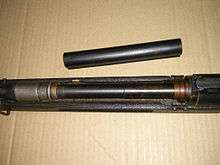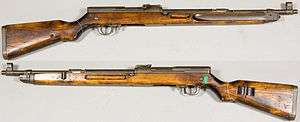vz. 52 rifle
| vz. 52 and vz. 52/57 | |
|---|---|
|
Vz. 52 from the Swedish Army Museum. | |
| Type | Semi-automatic rifle |
| Place of origin | Czechoslovakia |
| Service history | |
| In service | 1952–1959 |
| Used by | See Users |
| Wars | Invasion of Grenada[1] |
| Production history | |
| Designer | Jan and Jaroslav Kratochvíl |
| Designed | 1951–1952 |
| Manufacturer | Považské strojárne, Česká zbrojovka |
| Produced | 1952–1959 |
| Variants | vz. 52/57 |
| Specifications | |
| Weight |
4.14 kg (9.13 lb) (vz. 52) 4.30 kg (9.5 lb) (vz. 52/57) |
| Length |
1,005 mm (39.6 in) 1,205 mm (47.4 in) with bayonet deployed |
| Barrel length | 520 mm (20.5 in) |
|
| |
| Cartridge |
7.62×45mm (vz. 52) 7.62×39mm (vz. 52/57) |
| Action | Gas-operated, tilting breechblock |
| Rate of fire | 25 rounds/min (practical) |
| Muzzle velocity |
760 m/s (2,493 ft/s) (vz. 52) 735 m/s (2,411.4 ft/s) (vz. 52/57) |
| Effective firing range |
650 m (vz. 52) 400 m (vz. 52/57) |
| Maximum firing range | 1,000 m (vz. 52/57) |
| Feed system | Clip-fed, staggered-column, 10-round detachable box magazine |
| Sights | Open iron sights graduated from 100 to 900 m |
The vz. 52 rifle (often incorrectly called the "CZ 52") is a self-loading rifle developed shortly after the Second World War in Czechoslovakia. Its full name is 7.62mm samonabíjecí puška vzor 52.[2] Vz. 52 is an abbreviation for vzor 52, meaning "model 52". It fires the unique 7.62×45mm cartridge. It is considered both reliable and accurate. The first 5000 vz. 52 rifles were made by Považské strojárne in Považská Bystrica, but due to production difficulties, its manufacture was taken over by Česká zbrojovka Uherský Brod.[3]
Design details

The vz. 52 is a shoulder-fired semi-automatic rifle with a tilting-bolt locking mechanism powered by an annular short-stroke gas piston system. The bolt is locked by two lugs that recess into slots machined into the receiver. However, unlike most vertically-locking breech mechanism, the rifle's bolt has the unusual feature of tipping the bolt frontally to lock the mechanism, whereas other tipping bolt designs tip the bolt to the rear.[2] The piston is actuated by residual gases from the bore, vented into a sleeve surrounding the barrel to overcome the inertia of the bolt carrier, bolt and the resistance of the return spring in order to unlock the chamber, eject the empty cartridge casing and then introduce a new round into the chamber upon return to battery.
The barrel is press-fit and pinned into the receiver. The manual safety switch is placed inside of the trigger guard and is manipulated by the shooter's index finger. The trigger mechanism closely resembles that used in the American M1 Garand semi-automatic rifle. The cocking handle is integrated into the bolt carrier and is located on the right side of the rifle; this arrangement enables the shooter to reload the rifle without disturbing his aim.
The rifle is equipped with open-type iron sights with a hooded front post and V-notch rear sight placed on a sliding tangent, adjustable for elevation between 100–950 m. The rifle can also accept day and night-time optics that interface with an optional, receiver-mounted side rail. The one-piece pistol grip stock is carved from either walnut or beech and stained a yellowish-brown color; the stock has a hollowed butt which is used as a storage compartment for a cleaning rod, oil bottle and accessories. The rifle has an integral blade bayonet which folds into a recess carved into the stock on the right side.
The vz. 52 feeds from a detachable box magazine with a 10-round cartridge capacity but could also be rapidly recharged from stripper clips with the bolt retracted. For this purpose, a stripper clip guide is milled into the front face of the bolt carrier, aligning with the magazine when the bolt is locked in the open position. This is the primary method of reloading the rifle as infantrymen were only issued 2 magazines per rifle. It ejects cartridge cases vigorously forward and to the left.
Conversion
After pressure from the Soviet Union to adopt its 7.62×39mm cartridge, existing Czech rifles were rechambered to the Soviet caliber, and all further production of the rifle was chambered in this caliber and re-designated the vz. 52/57. The vz. 52/57 is identical except for its barrel and its magazines. It is considerably less common and are generally found in better condition due to the vz. 52/57 chromium-plated bore and chamber. The vz. 52 magazines can be used with the vz. 52/57, but they do not feed as reliably.
Decommissioning

All of the vz. 52 series were quickly replaced in Czechoslovak service by the vz. 58, but the earlier rifles found their way to Soviet allies during the Cold War, and have seen service in Grenada, Somalia, Cuba and Afghanistan and many of those were passed on to guerrillas.[2] The Czech Castle guard uses chrome-finished, deactivated vz. 52 rifles with darkened wood stocks as ceremonial weapons.
Users
 Cuba[3][4][5]
Cuba[3][4][5] Czechoslovakia[6]
Czechoslovakia[6] Egypt[3]
Egypt[3] Indonesia: service with the KorMar.[6]
Indonesia: service with the KorMar.[6] Israel[6]
Israel[6] Grenada (During the New Jewel Movement regime)[1]
Grenada (During the New Jewel Movement regime)[1] Guinea-Bissau: vz. 52/57.[7]
Guinea-Bissau: vz. 52/57.[7] Nicaragua[3]
Nicaragua[3] Nigeria[7]
Nigeria[7] Syria
Syria Yemen[7]
Yemen[7] Zimbabwe[8]
Zimbabwe[8]
See also
References
- 1 2 Lee E. Russel (1985). Grenade 1983. p. 45.
- 1 2 3 Bishop, Chris (2006). The Encyclopedia of Small Arms and Artillery. Grange Books. pp. 13–14. ISBN 978-1-84013-910-5.
- 1 2 3 4 Walter, John: Rifles of the World (3rd ed.), page 229. Krause Publications, 2006.
- ↑ "CZECHOSLOVAK CONSIDERATION OF CUBAN ARMS REQUESTS" (Communist Party of Czechoslovakia) (in Czech). Wilson Center Digital Archive. January 1961. Retrieved 15 May 2016.
Among his [Fidel Castro] other requests, it is necessary to mention the previous request to be supplied with 50 million 7.92[x57mm] bullets and 400,000 magazines for vz.52 self-loading rifles.
- ↑ MINFAR ( Ministry of Armed Forces) (1981). Manual basico del Miliciano de Tropas Territoriales (in Spanish). Habana: Editorial Orbe.
The tenth chapter, listing infantry weapons, refers to the Mauser vz. 24, Vz.52, AK-47 and AKM rifles in the inventory of the Territorial Troops Militia
- 1 2 3 McNab, Chris (2002). 20th Century Military Uniforms (2nd ed.). Kent: Grange Books. ISBN 1-84013-476-3.
- 1 2 3 Jones, Richard D.; Ness, Leland S., eds. (January 27, 2009). Jane's Infantry Weapons 2009/2010 (35th ed.). Coulsdon: Jane's Information Group. ISBN 978-0-7106-2869-5.
- ↑ Peter Abbott (1986). Modern African Wars (1) 1965-80. p. 10. ISBN 0850457289.
Bibliography
- Čermák, Jiří (1999). 40 let konstruktérem zbraní 1946-1986 (Od samopalu ČZ 247 ke zbraňovému kompletu LADA). Brno: Ardent. ISBN 80-238-3397-9.
- Popelínský, Lubomír (1999). Československé automatické zbraně a jejich tvůrci. Praha: Naše vojsko. ISBN 80-206-0567-3.
- Šáda, Miroslav (2004). Československé ruční palné zbraně a kulomety. Praha: Naše vojsko. ISBN 80-206-0745-5.
- Walter, John (2006). Rifles of the World (3rd ed.). Iola, WI: Krause Publications. ISBN 978-0-89689-241-5.
| Wikimedia Commons has media related to Vz.52 rifle. |
External links
(Italian)
